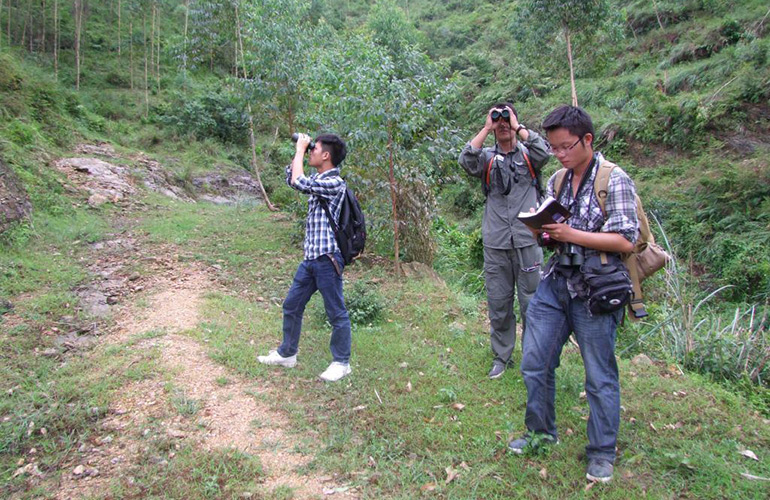Protecting a biodiversity hot-spot
When it comes to biodiversity, the Guangxi province has an interesting story to tell. Located by the border of Vietnam and the South China Sea, it was originally one of the country’s richest biodiversity areas but has been under intense human influence for centuries and very few pristine terrestrial ecosystems exist today. Even so, there is still immense potential for biodiversity in the area. Stora Enso has never converted any natural forests or protected areas to eucalyptus plantations in Guangxi. Instead the company goes to great lengths to establish buffers in order to help reintroduce native species.“For Stora Enso, it’s always important to monitor the sustainability of our operations throughout the forest management cycle, focusing on their impacts on biodiversity, soil, and water resources,” explains Ian Blanden, Stora Enso's General Manager for Forestry Operations in Beihai. “For us in Guangxi it has been especially important to make sure that the possible impacts of our large plantations are well known.”
Bird watching and vegetation mapping
The Guangxi province is located by a globally significant bird migratory route. Every autumn large flocks of birds including migratory predators like eagles, hawks, and kites fly along the seashore to the south. Consequently, the main agenda of the research project with Fauna & Flora International has been to conduct biodiversity baseline surveys with a special focus on birdlife. In addition, it has involved introducing both local Beihai residents and Stora Enso employees to nature conservation.
“During the seven-year project we have monitored both migratory and resident birds at eucalyptus plantations as well as in the non-eucalyptus woodlands. In practice this has meant, for example, that each year our team conducted more than 60 days of field monitoring,” explains Xingfeng Zhao, Biodiversity Monitoring Programme Manager at Fauna & Flora International China Programme. “We have also done vegetation monitoring with a special focus on the Geodorum densiflorum, also known as Nodding Swamp Orchid, which is endangered in the area.”

A monitoring team conducted more than 60 days of field monitoring yearly.
Protecting diversity with locals
To protect rare and endangered bird species in the area, Fauna & Flora International and Stora Enso have also engaged with locals and Stora Enso employees through campaigns and workshops. In total more than 100 Stora Enso employees and 50 public volunteers have attended the different training sessions.
“The active participation of our local staff has improved their understanding of how important sustainable forestry is for biodiversity as well as enhanced their general knowledge in sustainability,” says Blanden.
“Involving locals has also been important since in Guangxi some local people still hunt and eat wild birds for nutrition and medical traditions,” adds Zhao.
Thanks to the project, an increasing interest and excitement for nature conservation has risen. In addition to the official training sessions, the local team has organised a bird watching festival since 2013. The Beibu Gulf Bird Watching Festival, as it is now known, involves more than 200 bird watchers each autumn from mainland China, Hong Kong and Taiwan, as well as Stora Enso staff. This event is now run annually by bird watchers thanks to the initial support by Stora Enso Guangxi.
Taking results into action
The results of the seven-year monitoring show that eucalyptus plantations are well suited for birds, especially if they are planted in close proximity to buffers or other tree patches containing natural species.
“All in all, the most significant finding of the monitoring has been that as the eucalyptus trees grow on a particular plantation, the bird community increases too. This increase was especially fast during the first three to four years,” says Zhao. “The field monitoring also showed that a small open area, pond or even a broad-leaf tree in the patch of a eucalyptus plantation attracts more bird species.”
All the results and suggestions of the research have been taken into account in the way we manage our plantations.
“Understanding and protecting the biodiversity of our plantations is crucial for our business,” Blanden contends. “For example, diverse ground vegetation and animal manure improve the soil and help retain soil moisture.”
“Thanks to this long monitoring period that has involved the whole life-cycle of a plantation eucalyptus, we have been able to follow the different impacts on biodiversity and improve the sustainability of our forest operations. For example, now we better understand the importance of keeping the time period between the commencement of harvesting and the re-planting of the plantation to as short a time as possible. With mechanised harvesting and site preparation we have been able to reduce this period from a time span of 6 to 12 months into 1 to 3 months. This allows the site to start regrowing and providing a habitat for plants and animals as quickly as possible.”
* Stora Enso Communications’ FSC ® trademark license number is FSC-N001919.





